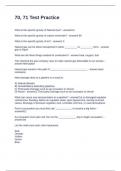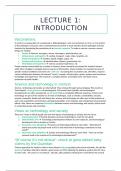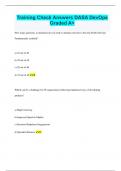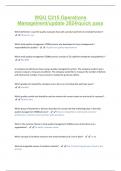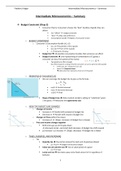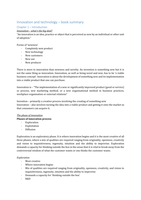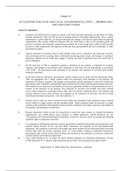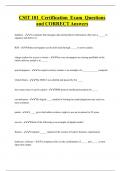Summary Marketing Communications
A European Perspecti ve (sixth editi on)
Chapter 3: How marketing communication works
Several factors impact the way consumers respond to marketing communications such as consumer goals, product
characteristics, situation of the consumer, involvement with product, etc.
Hierarchy-of-effects models
Hierarchy-of-effects models = a model that assumes that things have to happen in a certain order, implying that the
earlier effects form necessary condition in order for the later effects to occur. According to this model consumers go
through 3 different stages in responding to marketing communications:
1. Cognitive stage: mental (thinking) processes which lead to awareness and knowledge of the brand
2. Affective stage: emotional or evaluative responses occur associated with the brand and attitudes towards
the brand
3. Conative/behavioural stage: undertaking actions with respect to the brand (e.g., buying)
In the literature, disagreement towards this model exists and therefore researchers have developed alternative
models such as the low-involvement hierarchy-of-effects model (cognitive-conative-affective hierarchy) and the
experiential hierarchy-of-effects model (affective-conative-cognitive hierarchy).
Another model is the Foote-Cone-Belding (FCB) grid where
four different situations are distinguished based on two
dimensions: (1) high-low involvement and (2) think-feel (i.e.,
cognitive or affective).
Involvement = the importance people attach to a product or a
buying decision, the extent to which one has to think it over
and the level of perceived risk associated with an inadequate
brand choice.
Figure 1. FCB grid
1. Informative quadrant: think – feel – do (classical hierarchy)
2. Affective quadrant: feel – think – do
3. Habitual quadrant: do – think – feel as it is a routine/habit
4. Satisfaction quadrant: do – feel – think
Another model is Rossiter-Percy grid (modified from FCB grid) and has also two dimensions: (1) high-low
involvement and (2) fulfilling a transformational or informational buying motive. Transformational buying motives
consist of positive motivations (e.g., sensory gratification, social approval, or intellectual stimulation). Informational
buying motives refer to reducing or reversing negative motivations (e.g., solving/avoiding a problem or normal
depletion).
Advantages of hierarchy-of-effects models:
A framework for communications objectives and campaign effectiveness measurement
These models recognize the importance of brand awareness as brand awareness is considered as a
prerequisite for brand attitude formation. In other words, affective responses or purchases cannot be
formed/take place without being aware of a brand.
Disadvantages of hierarchy-of-effects models:
Empirical support for the fact that consumer go through each stage is lacking. Relation between recall and
attitudes has not been observed yet.
These models do not allow interactions between the different stages which is very unlikely.
,Attitude formation and change
Attitude = a person’s overall evaluation of an object, product, person, organisation, ad, etc.
An attitude towards a brand can be considered as a measure of how much a person like or dislikes the brand, or of
the extent to which he or she holds a favourable or unfavourable view of it. Attitude consists of three components:
1. Cognitive component: knowledge, beliefs, and evaluations
2. Affective component: feelings
3. Behavioural component: action readiness (i.e., behavioural intention)
Different communications models have been developed regarding attitude formation and attitude change which can
be classified along two dimensions: (1) how attitudes are formed (cognitive, affective, or conative) and (2) the level
of elaboration of a message (central-route vs. peripheral-route processing).
The involvement dimension of FCB grid is extended to motivation, ability, and opportunity (MAO).
Motivation = willingness to engage in behaviour, make decisions, pay attention, process information, etc. Motivation
is influence by consumer needs and goals. Consumer needs can be categorised as:
Functional needs: comparable with informational motivation dimension (Rossiter-Percy grid) and pertain to
solving consumer problems
Symbolic needs: how we see ourselves and how we want to be perceived by others.
Hedonic needs: consumers’ desires for sensory pleasure
Consumer needs/goals can also be categorized as (1) approach or promotion goals (i.e., positive outcome) or (2)
avoidance or prevention goals (i.e., avoid negative outcome).
Ability = the resources needed to achieve a particular goal (e.g., knowledge or money).
Opportunity = the extent to which the situation enables a person to obtain the goal set (e.g., situation in
supermarket or at home or information on an ad)
The Elaboration Likelihood Model (ELM) presents the effects of MAO factors on attitude formation and marketing
communications processing. If MAO is high, the elaboration likelihood is said to be high and consumers are expected
to engage in central-route processing. This means that they are willing to elaborate on the information, to evaluate
the arguments, and find out what the information really has to offer. If one or more of the MAO factors is/are low,
consumers are more likely to process the information peripherally (=peripheral-route processing). This means that
there is no real information processing, but an evaluation based on simple, peripheral cues (e.g., background music
or humour). Attitude formation is temporary and affective whereas attitude change in central-route processing is
more permanent and cognitive.
In addition to MAO, consumers’ goals also determine whether attitude formation is cognitive or affective. When
individuals focus on ideals (promotion goals, wishes and aspiration, e.g., exotic holiday) evaluation is based on affect.
When consumers’ ‘oughts’ (prevention goals, obligation and responsibilities, e.g., child’s education) are their driving
goals evaluation is more cognitive.
Elaboration likelihood based on motivation/involvement, ability and opportunity
High elaboration central-route Low elaboration peripheral-route
processing processing
Attitudes Cognitions - Multi-attribute models - Heuristic evaluation
based on: - Self-generated persuasion
Affect - Feelings-as-information model - Ad transfer
- Feelings transfer
- Classical conditioning
- Mere exposure effect
Behaviour - Post-experience model - Reinforcement model
- Perception-experience-memory model - Routinised response behaviour
Table 1. Six types of attitude formation and change
, High elaboration likelihood, cognitive attitude formation
Models discussed in this paragraph are relevant when MAO is high and when cognitive elements are important for
attitude formation. For example, comparing different brands on several attributes before buying a home video
installation.
Multiple attribute models
In the Fishbein model (Expectancy-Value model) brand attitudes are made up of three elements: product attributes,
the extent to which one believes the brand possesses these attributes, and the evaluation of these attributes. More
specifically, brand attitude is represented by the weighted sum of the products of the brand beliefs and attribute
n
evaluations. Formula: Ao =∑ b o e i (where: A0 = attitude towards object 0, boi = belief of the object o possessing
i
i=1
attribute i, ei = evaluation of attribute I and n = number of attributes)
The Theory of Reasoned Action (TORA) is an extension of the
Expectancy-Value model and provides a link between attitude and
behavioural intention. The latter is determined by attitudes and
subjective norm. A subjective norm comprises the belief one holds
regarding what different reference groups consider as socially
desirable behaviour, weighted by the consumer’s need or
willingness to behave according to the norms of the particular
reference group (=social sensitivity). TORA has been further
extended to the Theory of Planned Behaviour (TPB). This extension
deals with behaviour over which people have incomplete volitional
control (i.e., non-motivational factors such as resources). Perceived
behavioural control is added and defined as the perceived ease or
difficulty of performing the behaviour and it is assumed to reflect
Figure 2. TORA and TPB past experience as well as anticipated impediment and obstacles. It
is computed by multiplying control beliefs by perceived power.
Marketing communications can try to change consumers’ attitudes and influence their behaviour in several ways:
Change brand beliefs
Change attribute evaluations
Add attributes
Change social sensitivity (i.e., opinion of others)
Influence perceived behavioural control:
o Change control beliefs
o Change perceived power
Self-generated persuasion
Self-generated persuasion is another form of central-route, cognitively based processing. Consumer is persuaded by
his/her own thoughts, arguments or imagined consequences (and not by brand arguments). Information in a
message is combined with previous experience and knowledge. The persuasive process is imagery-based.
Low elaboration likelihood, cognitive attitude formation
In this case, one of the MAO factors is low and the consumer focusses on peripheral cues. Inferences will be made
based on the cue (e.g., ad characteristics) in order to form a cognitively based attitude. This process is called
heuristic evaluation (i.e., satisficing choice process). Consumers seek for reassurance or credibility in heuristic cues.
Peripheral cues are:
Source
o Attractiveness: the more attractive, the better
o Expertise: the more expertise, the better
o Status: the higher the status, the better
A European Perspecti ve (sixth editi on)
Chapter 3: How marketing communication works
Several factors impact the way consumers respond to marketing communications such as consumer goals, product
characteristics, situation of the consumer, involvement with product, etc.
Hierarchy-of-effects models
Hierarchy-of-effects models = a model that assumes that things have to happen in a certain order, implying that the
earlier effects form necessary condition in order for the later effects to occur. According to this model consumers go
through 3 different stages in responding to marketing communications:
1. Cognitive stage: mental (thinking) processes which lead to awareness and knowledge of the brand
2. Affective stage: emotional or evaluative responses occur associated with the brand and attitudes towards
the brand
3. Conative/behavioural stage: undertaking actions with respect to the brand (e.g., buying)
In the literature, disagreement towards this model exists and therefore researchers have developed alternative
models such as the low-involvement hierarchy-of-effects model (cognitive-conative-affective hierarchy) and the
experiential hierarchy-of-effects model (affective-conative-cognitive hierarchy).
Another model is the Foote-Cone-Belding (FCB) grid where
four different situations are distinguished based on two
dimensions: (1) high-low involvement and (2) think-feel (i.e.,
cognitive or affective).
Involvement = the importance people attach to a product or a
buying decision, the extent to which one has to think it over
and the level of perceived risk associated with an inadequate
brand choice.
Figure 1. FCB grid
1. Informative quadrant: think – feel – do (classical hierarchy)
2. Affective quadrant: feel – think – do
3. Habitual quadrant: do – think – feel as it is a routine/habit
4. Satisfaction quadrant: do – feel – think
Another model is Rossiter-Percy grid (modified from FCB grid) and has also two dimensions: (1) high-low
involvement and (2) fulfilling a transformational or informational buying motive. Transformational buying motives
consist of positive motivations (e.g., sensory gratification, social approval, or intellectual stimulation). Informational
buying motives refer to reducing or reversing negative motivations (e.g., solving/avoiding a problem or normal
depletion).
Advantages of hierarchy-of-effects models:
A framework for communications objectives and campaign effectiveness measurement
These models recognize the importance of brand awareness as brand awareness is considered as a
prerequisite for brand attitude formation. In other words, affective responses or purchases cannot be
formed/take place without being aware of a brand.
Disadvantages of hierarchy-of-effects models:
Empirical support for the fact that consumer go through each stage is lacking. Relation between recall and
attitudes has not been observed yet.
These models do not allow interactions between the different stages which is very unlikely.
,Attitude formation and change
Attitude = a person’s overall evaluation of an object, product, person, organisation, ad, etc.
An attitude towards a brand can be considered as a measure of how much a person like or dislikes the brand, or of
the extent to which he or she holds a favourable or unfavourable view of it. Attitude consists of three components:
1. Cognitive component: knowledge, beliefs, and evaluations
2. Affective component: feelings
3. Behavioural component: action readiness (i.e., behavioural intention)
Different communications models have been developed regarding attitude formation and attitude change which can
be classified along two dimensions: (1) how attitudes are formed (cognitive, affective, or conative) and (2) the level
of elaboration of a message (central-route vs. peripheral-route processing).
The involvement dimension of FCB grid is extended to motivation, ability, and opportunity (MAO).
Motivation = willingness to engage in behaviour, make decisions, pay attention, process information, etc. Motivation
is influence by consumer needs and goals. Consumer needs can be categorised as:
Functional needs: comparable with informational motivation dimension (Rossiter-Percy grid) and pertain to
solving consumer problems
Symbolic needs: how we see ourselves and how we want to be perceived by others.
Hedonic needs: consumers’ desires for sensory pleasure
Consumer needs/goals can also be categorized as (1) approach or promotion goals (i.e., positive outcome) or (2)
avoidance or prevention goals (i.e., avoid negative outcome).
Ability = the resources needed to achieve a particular goal (e.g., knowledge or money).
Opportunity = the extent to which the situation enables a person to obtain the goal set (e.g., situation in
supermarket or at home or information on an ad)
The Elaboration Likelihood Model (ELM) presents the effects of MAO factors on attitude formation and marketing
communications processing. If MAO is high, the elaboration likelihood is said to be high and consumers are expected
to engage in central-route processing. This means that they are willing to elaborate on the information, to evaluate
the arguments, and find out what the information really has to offer. If one or more of the MAO factors is/are low,
consumers are more likely to process the information peripherally (=peripheral-route processing). This means that
there is no real information processing, but an evaluation based on simple, peripheral cues (e.g., background music
or humour). Attitude formation is temporary and affective whereas attitude change in central-route processing is
more permanent and cognitive.
In addition to MAO, consumers’ goals also determine whether attitude formation is cognitive or affective. When
individuals focus on ideals (promotion goals, wishes and aspiration, e.g., exotic holiday) evaluation is based on affect.
When consumers’ ‘oughts’ (prevention goals, obligation and responsibilities, e.g., child’s education) are their driving
goals evaluation is more cognitive.
Elaboration likelihood based on motivation/involvement, ability and opportunity
High elaboration central-route Low elaboration peripheral-route
processing processing
Attitudes Cognitions - Multi-attribute models - Heuristic evaluation
based on: - Self-generated persuasion
Affect - Feelings-as-information model - Ad transfer
- Feelings transfer
- Classical conditioning
- Mere exposure effect
Behaviour - Post-experience model - Reinforcement model
- Perception-experience-memory model - Routinised response behaviour
Table 1. Six types of attitude formation and change
, High elaboration likelihood, cognitive attitude formation
Models discussed in this paragraph are relevant when MAO is high and when cognitive elements are important for
attitude formation. For example, comparing different brands on several attributes before buying a home video
installation.
Multiple attribute models
In the Fishbein model (Expectancy-Value model) brand attitudes are made up of three elements: product attributes,
the extent to which one believes the brand possesses these attributes, and the evaluation of these attributes. More
specifically, brand attitude is represented by the weighted sum of the products of the brand beliefs and attribute
n
evaluations. Formula: Ao =∑ b o e i (where: A0 = attitude towards object 0, boi = belief of the object o possessing
i
i=1
attribute i, ei = evaluation of attribute I and n = number of attributes)
The Theory of Reasoned Action (TORA) is an extension of the
Expectancy-Value model and provides a link between attitude and
behavioural intention. The latter is determined by attitudes and
subjective norm. A subjective norm comprises the belief one holds
regarding what different reference groups consider as socially
desirable behaviour, weighted by the consumer’s need or
willingness to behave according to the norms of the particular
reference group (=social sensitivity). TORA has been further
extended to the Theory of Planned Behaviour (TPB). This extension
deals with behaviour over which people have incomplete volitional
control (i.e., non-motivational factors such as resources). Perceived
behavioural control is added and defined as the perceived ease or
difficulty of performing the behaviour and it is assumed to reflect
Figure 2. TORA and TPB past experience as well as anticipated impediment and obstacles. It
is computed by multiplying control beliefs by perceived power.
Marketing communications can try to change consumers’ attitudes and influence their behaviour in several ways:
Change brand beliefs
Change attribute evaluations
Add attributes
Change social sensitivity (i.e., opinion of others)
Influence perceived behavioural control:
o Change control beliefs
o Change perceived power
Self-generated persuasion
Self-generated persuasion is another form of central-route, cognitively based processing. Consumer is persuaded by
his/her own thoughts, arguments or imagined consequences (and not by brand arguments). Information in a
message is combined with previous experience and knowledge. The persuasive process is imagery-based.
Low elaboration likelihood, cognitive attitude formation
In this case, one of the MAO factors is low and the consumer focusses on peripheral cues. Inferences will be made
based on the cue (e.g., ad characteristics) in order to form a cognitively based attitude. This process is called
heuristic evaluation (i.e., satisficing choice process). Consumers seek for reassurance or credibility in heuristic cues.
Peripheral cues are:
Source
o Attractiveness: the more attractive, the better
o Expertise: the more expertise, the better
o Status: the higher the status, the better


